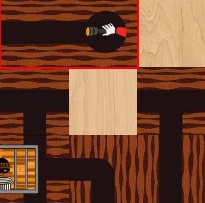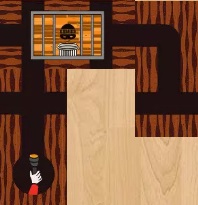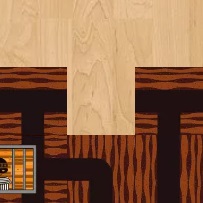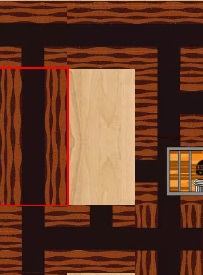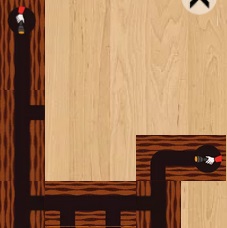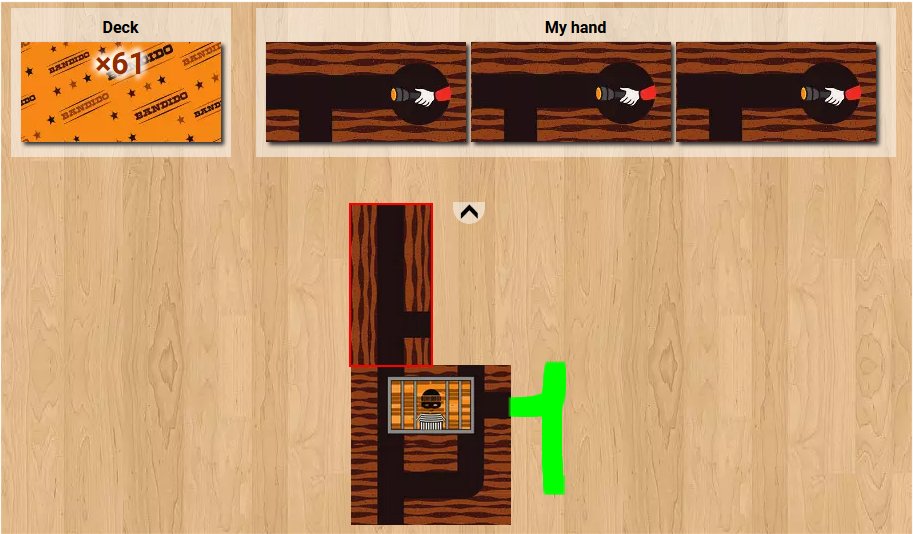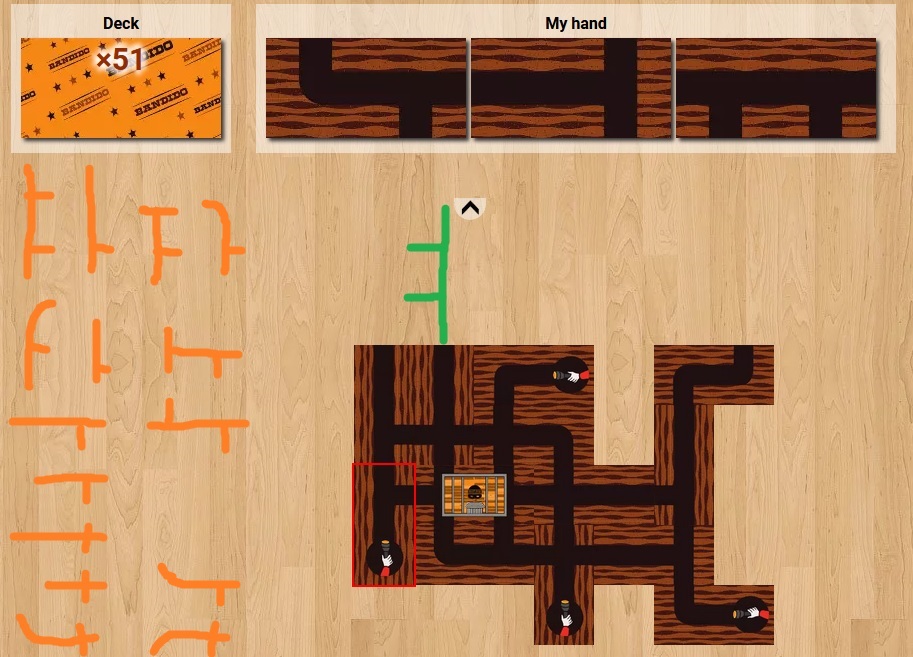This is a documentation for Board Game Arena: play board games online !
Tips bandido: Difference between revisions
(Advanced section added) |
m (change on one tip) |
||
| Line 20: | Line 20: | ||
* try to create various patterns. If you got many single exit accross the board, it's very bad to create more of them. | * try to create various patterns. If you got many single exit accross the board, it's very bad to create more of them. | ||
* for begginner and average players, it is avised to keep at all times in your hand one single exit tile, and one torch two exit tile in a corner while there is 4+ exits on the board. Even if you got no good place to play, you can usually play on a safe spot, open more exits but that will give you more options in your next turn. If you see that both players do it, that mean that any time you will goes under 3 exits, you will win immediately. But having more exits give usually more options. The game is a succession of weak moments where everyone tries to have a good hand, and some strong ones when everyone tries to win the game. | * for begginner and average players, it is avised to keep at all times in your hand one single exit tile, and one torch two exit tile in a corner while there is 4+ exits on the board. Even if you got no good place to play, you can usually play on a safe spot, open more exits but that will give you more options in your next turn. If you see that both players do it, that mean that any time you will goes under 3 exits, you will win immediately. But having more exits give usually more options. The game is a succession of weak moments where everyone tries to have a good hand, and some strong ones when everyone tries to win the game. | ||
* the torch two exit tile is the best tile of the game, above the one exit tile. Don't waste them without reason. If there is one exit left, I try to give one timing to my teammate to try to end the game. If I have seen they didn't kept one of the three differents one exit tile, I will not play a torch two exit tile on it unless I assume the odds to win are low. | * the torch two exit tile is the best tile of the game, above the one exit tile. Don't waste them without reason. If there is one exit left, I try to give one timing to my teammate to try to end the game. If I have seen they didn't kept one of the three differents one exit tile, I will not play a torch two exit tile on it unless I assume the odds to win are low. (instead, transforming that single exit I into an U give more options to your teammate to try to win. He could have an U and you win, he could have a torch two exit which can make the game win with yours, or you could transform it back into an I, and if he tempo, you have 5 extra chances to try to draw a 1-exit tile instead of 1 or 2). | ||
* many 2-exits tiles don't accomplish much and are just situationnally good. But often you will just want to play them on a single exit to draw a new card and have more option during your next turn. | * many 2-exits tiles don't accomplish much and are just situationnally good. But often you will just want to play them on a single exit to draw a new card and have more option during your next turn. | ||
* when there is more than one single exit far from the others on the board: immediately close it at 1 player (no upside to hold your one exit tile), at 2 players for beginner and average players, I advise you to keep one 1-exit tile in hand, and play your extra ones. | * when there is more than one single exit far from the others on the board: immediately close it at 1 player (no upside to hold your one exit tile), at 2 players for beginner and average players, I advise you to keep one 1-exit tile in hand, and play your extra ones. | ||
Revision as of 17:57, 22 May 2024
General Tips:
- Familiarize yourself with all the tiles as quickly as possible so you know the possibilities.
- At the beginning of your turn, select and rotate each of your tiles in order to see all your options. Take care not to double-click until you are ready to commit to a placement.
- In general, try to join or extend tunnels rather than splitting them. An exception is if you create a branching situation that you or a teammate can quickly resolve with a complementary piece. Another is if you must either split the tunnel or waste a valuable piece without confidence that the tunnel will soon be closed; in this case it is sometimes preferable to split the tunnel.
- If you need to play a tile that adds exits, try to align open ends in a parallel or perpendicular grouping which can then be closed or combined with complementary tiles.
- If the tunnels start to branch too much to contain, switch to using ends sparingly and strategically. An example of strategic use would be to close a tunnel that is far from all others. An example of a wasteful use would be to use a corner end or T end to simply extend a line - only do this if you are confident that someone can close the tunnel within the round.
- Remember, there are only two of each tunnel type and three of each end type in the standard game. Keep track of what has been used and what is still available. If you need to, search the table to make sure a piece is available before you create a situation that requires a specific piece. The "wood grain" design always follows the length of the tile; this will help you distinguish each tile from adjacent tiles.
- Try to direct tunnels toward each other and keep the exits close to each other so that they may be joined if possible. Like on this picture where playing that tile the other way around will make the two exits way further:
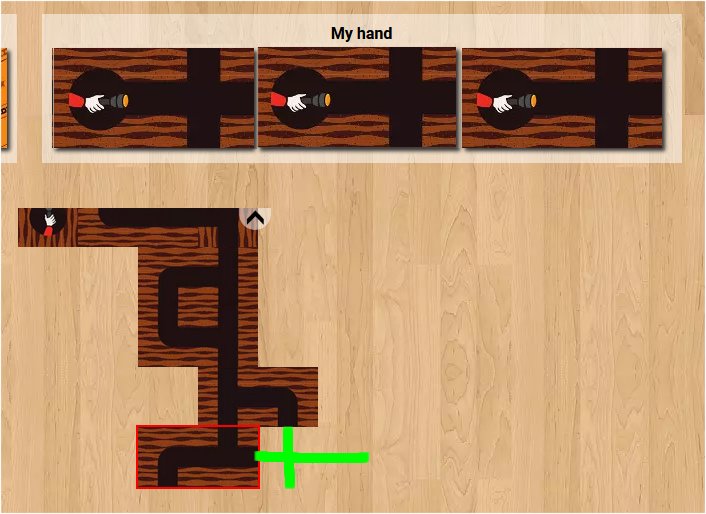
On this one, you play it like that to make the exits the most close possible. Furthermore, you have the possibility to get the third exit in the top maybe. Don't force it, but it's an upside: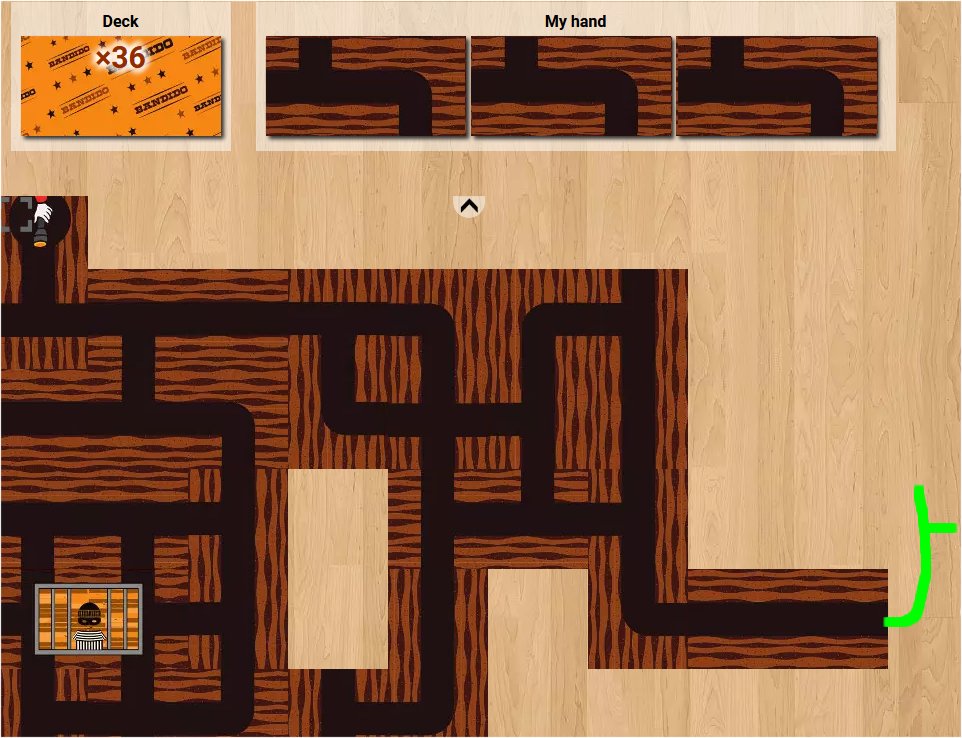
- There are only two I, S, and Z tiles, so joining distant exits is not likely to work.
- Try to figure out what your teammates are attempting to accomplish. If you see a teammate laying parallel lines, try to maintain the parallel lines until a U -tile can close them. The more familiar you are with the deck, the more easily you can see your teammate(s) building an arrangement that can be resolved nicely by a few specific pieces. If the perfect piece to resolve a situation is still out there somewhere but you don't have it, try to play somewhere else and be patient. The right piece will come, or maybe your teammate already has it!
- Be careful of the constraints that develop if you add tiles to a confined area. You’ll lose the game if you can’t close or route the tunnel out of the confined area. Try to point new open ends away from confined space so you’re less likely to encounter constraints with tiles that follow (unless you are building a trap intentionally as described below).
Advanced:
- try to create various patterns. If you got many single exit accross the board, it's very bad to create more of them.
- for begginner and average players, it is avised to keep at all times in your hand one single exit tile, and one torch two exit tile in a corner while there is 4+ exits on the board. Even if you got no good place to play, you can usually play on a safe spot, open more exits but that will give you more options in your next turn. If you see that both players do it, that mean that any time you will goes under 3 exits, you will win immediately. But having more exits give usually more options. The game is a succession of weak moments where everyone tries to have a good hand, and some strong ones when everyone tries to win the game.
- the torch two exit tile is the best tile of the game, above the one exit tile. Don't waste them without reason. If there is one exit left, I try to give one timing to my teammate to try to end the game. If I have seen they didn't kept one of the three differents one exit tile, I will not play a torch two exit tile on it unless I assume the odds to win are low. (instead, transforming that single exit I into an U give more options to your teammate to try to win. He could have an U and you win, he could have a torch two exit which can make the game win with yours, or you could transform it back into an I, and if he tempo, you have 5 extra chances to try to draw a 1-exit tile instead of 1 or 2).
- many 2-exits tiles don't accomplish much and are just situationnally good. But often you will just want to play them on a single exit to draw a new card and have more option during your next turn.
- when there is more than one single exit far from the others on the board: immediately close it at 1 player (no upside to hold your one exit tile), at 2 players for beginner and average players, I advise you to keep one 1-exit tile in hand, and play your extra ones.
- when you got a 'three quarters of an H' usually play it on a single exit, that give more options. Exception is you already got a lot of that 'U pattern' and/or you got many single exits in hand. But still, transforming two exits close to each other into one exit is pretty bad: if you add a 3 or 4 exits tile, it will be nearly always worst on I than on a U. You can do the same with the F tiles by transforming a single exit I into an U. And you can play that same tile again to transform an U into an F. (And you can play that tile a third time but the other type to close all three exits yeah :D)
- check the F pattern below. Try to create one of each type if possible. If you keep a one torch two exit tile you will be able to play on it and create a three way trap.
- when there is three exits left: one solo I, and two in a corner and if you can close both, close the solo first, that way your teammate will play on the double and often give one exit left you can tempo by playing your other tile, and he can end the game with his solo exit.
- for experienced player, you shouldn't keep your two tiles at all times. Playing them early has the downside of making it more difficult to end the game which is really bad. But closing a solo exit can be good if there is another solo exit far away. If there is none, that can be good to give you more options. if you got a torch two exit tile, closing that exact pattern is usually bad. But if you assume your two others tiles are great to keep (there is others valuable tiles like an U, or the F), that can be good to do.
Traps:
An advanced and enjoyable technique is to create a "trap"; i.e. a completely enclosed space which can only be filled by a specific tile.
This let you close everything except the trap first, then close the trap. One of the upside is that the exits which are part of the trap don't need to be closed immediately. Another one is that if you can close a trap with one of your cards, you can keep it in hand, which let you when there is only one exit left outside of the traps, make you 'pass your turn' by closing the trap, or close the single exit left, hope your teammate can't play in the trap, and then close the trap.
Traps are good early on because many tiles can fill it. More the game advance, and less traps are effectives.
When you can play a card, you must a play card.
If at any point, you got a trap of size 1x1 like presented here, or if there is no tiles remaining to fill the gap, the game is immediately lost.
If one turn before the picture was taken (i.e. without the top torch) there was 3 exits left on the picture, and I was left with three I-torches, I would be forced to play like I did on the picture, and the game would be lost.
The most common is the "3-way trap". Since tiles have 4 exits at most, in worst case, that trap will give a single exit after being filled.
Adding tiles without exits at the bottom left or the bottom right of the picture is great because it reduces the amount of 4exits tiles which can fill the trap, which make it more likely to win the game when it's the only exits left.
They must be without exits leading to the trap: if you add a single exit torch to the bottom of it, you will then be left with a 1x1 square and lose immediately.
The second most common is the "2-way trap". Far worse, many tiles can fill the gap on it while still leaving 1 or 2 exits. You shouldn't force it, but if you got a nice tile to play and create that trap, this look good.
If already one trap of that type is present, it is advisedto avoid create another one.
The third one (enclosed 2x1 trap) can have various patterns, point is, you got an empty space of size 1x2. Before doing it, you need to check if the tile missing is still present on the deck.
Note when you do a trap like this, you force one tile of that type to goes there. Which mean, if it's a valuable tile, like the one of this trap, this is usually not good.
Cards with 4 exits are usually worst than others, so doing this trap with exactly 4 exits is better.
If you got the missing tile, you shouldn't rush to play it, since it's the only tile of that type which goes there, it can be used to pass your turn. With 2 players, if at least one of the player hold into it, you are close to have all the advantage to a 5 card hand together. But if you got nothing great to play, or if your other tiles in hand are great, don't hold into it too much.
Tiles with two exits down like presented here and some exits top are usually the worst one. So when creating a trap like that, putting exits far from each other is usually better.
When you got that trap nearly fully done (5/6 parts around it) with 3 exits or less on it actually, you get some value on not closing the trap immediately. Because you can in many cases have the choice between adding an extra exit to it or not. You should try in most cases to add an extra exit, but sometimes you can close the trap by having either a single exit torch or a double exit /-torch, which gave you more liberty.
This pattern is great (one exit maybe trap), you got a single exit which lead to a 2x1 space under it. This isn't a trap, but it let you easily create the one above it.
When there is few exits left, you can either close it normally, or create a trap and play an annoying card, sometimes while leaving no new exits outside of the trap, and make the next player play.
Traps of size 2x2 are mostly safes. The probability to lose with them is really low: it's when you play a tile which make the remaining trap have no copies left, or have 5 or 6 exits.
Patterns:
If you are experienced, by following this strategy, you will see that often times, you will finish by having only problem tiles and one exit left, and be forced to use that annoying tile. To reduce the amount of time you or your teammates will be forced to do that, you want to create various empty places for each player. Some 'U', some corners '┘', and even some 'L' (so with two exits not at the same 1x1 tile). Going straight up for the move which give the less exits is normally not optimal. On that example, you want to give your team a maximum amount of options. Here there are 4 single exits, so you want to play your three-exit tile, which will give more options to your teammate:
I will insist on that part, since many master players don't do it, when having this hand, doing this is better. Playing that last tile the 'normal way' will create three unique path III, which isn't good.
On the other hand doing this create two II, and one F. And F are extremely valuable, because many of the other tiles can be played on it. You can see on the left most of the tiles which goes nicely on it. And most of them are not easy to use.
So rarely it will backfire to you, but often, you will be able to play one or two complicated tiles on it.
Even if winning seems unlikely, play your best and don't give up. Games can be won even in the very last round with an empty deck!
